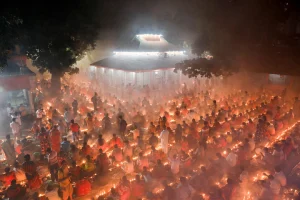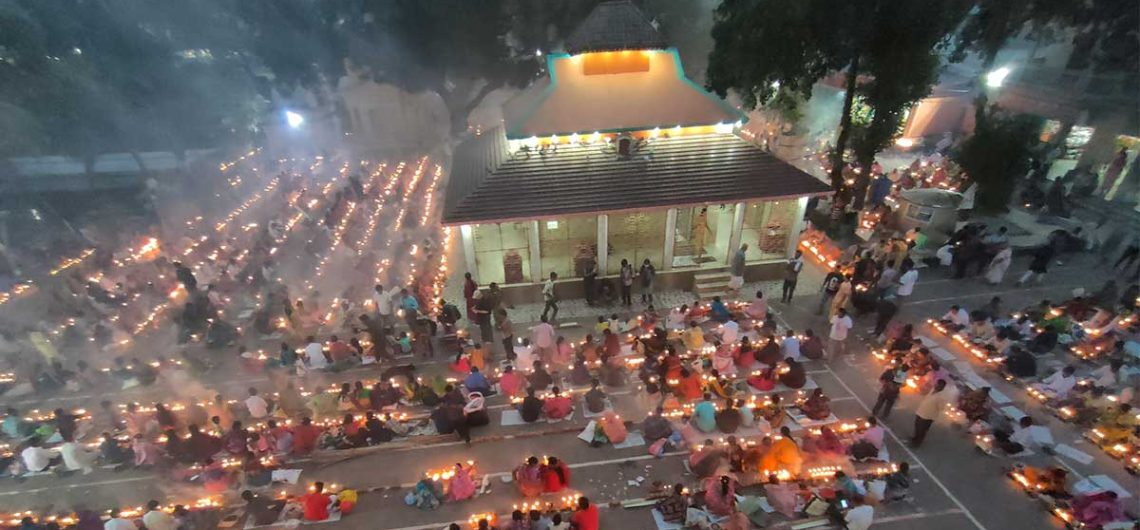Rash Mela Rakher Utshob, also known as Rash Yatra, is an annual festival celebrated with great zeal and enthusiasm in various parts of India and Bangladesh. It is a vibrant cultural extravaganza that blends religious fervor with traditional festivities, attracting pilgrims, tourists, and locals alike. Let’s delve into the origins, rituals, significance, and challenges associated with this colorful celebration.
History and Origin
Legend of Rash Mela (Rakher Utshob)
Rash Mela, an age-old tradition embedded in the vibrant tapestry of Bengali culture, beckons travelers from far and wide to immerse themselves in its mystical allure. This annual festival celebrated with fervor and grandeur, holds a significant place in the hearts of devotees and revelers alike.
A Celebration of Divine Love
At the heart of Rash Mela (Rakher Utshob) lies a profound tale of love and devotion. Legend has it that Lord Krishna, the epitome of divine love, once visited the enchanting forests of Sundarbans with his beloved Radha and the Gopis. It was here, amidst the lush greenery and tranquil waters, that the divine couple indulged in joyous festivities and celestial dances.
The Tradition Unfolds: Rituals and Revelries
Rash Mela unfolds over a span of three days, each brimming with spiritual fervor and cultural extravaganza. Devotees throng to the sacred grounds, adorned in vibrant attire, to pay homage to the divine couple. The air is filled with the melodious strains of devotional songs, invoking the blessings of Radha and Krishna.
A Feast for the Senses: Gastronomic Delights
No festival is complete without a delectable array of culinary delights, and Rash Mela is no exception. From traditional Bengali sweets like Rasgulla and Sandesh to savory treats such as Puchka and Jhalmuri, the festival offers a feast for the senses. Food stalls line the streets, tempting visitors with their aromatic offerings and flavorful delicacies.
Cultural Extravaganza: Music, Dance, and Theater
Rash Mela is not just a religious festival; it is a celebration of Bengali culture in all its glory. From vibrant folk dances like Baul and Chhau to mesmerizing music performances, the festival showcases the rich heritage of the region. Traditional plays and recitals add a touch of drama and entertainment to the proceedings, captivating audiences of all ages.

Embracing the Spirit of Unity and Harmony
Beyond its religious and cultural significance, Rash Mela embodies the spirit of unity and harmony. It transcends barriers of caste, creed, and religion, bringing people together in a celebration of love and humanity. In a world fraught with divisions, Rash Mela serves as a beacon of hope and solidarity, reminding us of the power of love to unite hearts and souls.
Evolution of the Festival
Over the centuries, Rash Mela has evolved from a simple village gathering into a grand cultural event. What once started as a religious observance has now become a platform for showcasing art, music, dance, and traditional crafts. The festival has transcended religious boundaries, embracing people from all walks of life.
Celebrations and Rituals
Preparations
Months before the festival, preparations begin with great fervor. Temples are adorned with colorful decorations, and makeshift stalls line the streets, offering an array of delicacies and handicrafts. Devotees eagerly anticipate the festivities, making arrangements for accommodation and transportation.
Processions and Performances
The highlight of Rash Mela is the vibrant processions that wind through the streets, accompanied by lively music and dance performances. Devotees dressed in elaborate costumes pay homage to Lord Krishna and Radha, carrying ornate palanquins and chanting devotional songs. Traditional folk artists entertain the crowds with their mesmerizing performances, adding to the festive atmosphere.
Offerings and Prayers
At the heart of Rash Mela lies devotion and piety. Devotees throng the temples to offer prayers and seek blessings for prosperity and well-being. Elaborate rituals are performed, including the offering of flowers, fruits, and sweets to the deities. It is believed that participating in these rituals brings spiritual fulfillment and blessings from the divine.

Significance and Symbolism
Cultural Importance
Rash Mela holds immense cultural significance as it celebrates the rich heritage and traditions of the region. It serves as a platform for preserving and promoting indigenous art forms, cuisine, and craftsmanship. The festival fosters cultural exchange and mutual respect among diverse communities, strengthening social bonds.
Religious Significance
For devout Hindus, Rash Mela is a sacred occasion to express their devotion and reverence towards Lord Krishna and Radha. It is a time for introspection and spiritual rejuvenation, as devotees immerse themselves in prayer, meditation, and acts of charity. The festival reinforces the belief in the power of love and devotion to transcend worldly boundaries.
Impact on Local Communities
Economic Aspects
Rash Mela plays a vital role in stimulating the local economy, and providing livelihood opportunities for artisans, vendors, and hospitality workers. The influx of tourists and pilgrims boosts trade and commerce, generating revenue for businesses and boosting the overall prosperity of the region.
Social Cohesion
The festival fosters a sense of unity and solidarity among communities, transcending barriers of caste, creed, and ethnicity. It promotes social cohesion and mutual respect, as people from diverse backgrounds come together to celebrate a shared cultural heritage. Rash Mela serves as a platform for fostering inter-community harmony and understanding.

Challenges and Controversies
Environmental Concerns
Despite its cultural significance, Rash Mela is not without its challenges. The massive influx of visitors often leads to environmental degradation, with littering and pollution posing a threat to the fragile ecosystem. Efforts are underway to promote eco-friendly practices and ensure sustainable management of resources.
Safety Issues
Crowd management and safety remain major concerns during Rash Mela, with overcrowding and stampedes posing risks to public safety. Authorities are implementing stringent measures to regulate crowd flow, enhance security, and prevent untoward incidents. It is imperative to prioritize the safety and well-being of all participants to ensure a smooth and hassle-free festival experience.
Famous Rash Melas Across the World
Rash Melas (Rakher Utshob) , celebrated across the world, offers a kaleidoscope of cultural vibrancy and traditional richness. These festive gatherings bring together communities, fostering unity and joy amidst colorful rituals and age-old traditions.
Bangladesh: Embracing Tradition with Rash Melas
In Bangladesh, Rash Melas are celebrated with fervor, blending spiritual reverence with joyful revelry. The Rash Mela at Dublar Char Island, dedicated to the Hindu deity Kali, draws devotees from far and wide, offering prayers and partaking in traditional rituals amidst the serene backdrop of the Sundarbans.
India: A Tapestry of Rash Melas
In India, Rash Melas are deeply rooted in the cultural fabric, with each region boasting its unique festivities. From the exuberant Pushkar Fair in Rajasthan to the sacred Kumbh Mela along the banks of the Ganges, these gatherings attract millions of pilgrims and tourists alike, showcasing India’s diverse heritage.
Nepal: Revering Culture through Rash Melas
Nepal, adorned with its majestic Himalayan landscape, hosts vibrant Rash Melas that resonate with spiritual significance. The Janai Purnima Mela, celebrated at the sacred site of Gosaikunda, embodies the essence of Nepalese culture, as devotees immerse themselves in rituals and seek blessings for prosperity and well-being.
Thailand: Captivating Festivities of Rash Melas
In Thailand, the vibrant Loy Krathong festival captivates with its enchanting beauty and cultural splendor. Also known as the Festival of Lights, this Rash Mela sees thousands of floating lanterns adorning the night sky, symbolizing the release of worries and offering prayers for good fortune.

Future of Rash Mela
Honoring Tradition Amidst Modernity
Rash Mela-rakher upobash, also known as Rash Yatra, is deeply entrenched in the rich tapestry of Bengali culture. It commemorates the divine love between Lord Krishna and Radha, celebrated with fervor and devotion by millions across the globe. Amidst the rapid march of modernity, Rash Mela stands as a steadfast bastion of tradition, preserving age-old customs and rituals that serve as a beacon of cultural heritage.
Embracing Innovation: The Digital Frontier
In an age dominated by technological advancements, the future of Rash Mela (Rakher Utshob) beckons towards embracing innovation while staying true to its essence. Digital platforms have emerged as powerful tools for connecting communities and disseminating cultural narratives. From virtual reality experiences that transport participants to the banks of the Yamuna River to interactive online forums discussing the significance of Ras Leela, technology offers myriad opportunities to enhance engagement and accessibility.
Cultural Diplomacy: Bridging Boundaries
As globalization continues to shrink the world, Rash Mela Rakher Utshob emerges as a potent force for cultural diplomacy, transcending geographical boundaries and fostering cross-cultural understanding. International collaborations, cultural exchanges, and diplomatic initiatives serve to amplify the resonance of Mela on a global scale, fostering goodwill and mutual appreciation among diverse communities.
Sustainable Celebrations: Nurturing Our Environment
In an era marked by environmental consciousness, the future of Rash Mela necessitates a shift towards sustainability and eco-conscious practices. From biodegradable decorations adorning the festival grounds to initiatives promoting waste management and conservation, prioritizing environmental stewardship ensures that Rash Mela remains a celebration not just for the present, but for generations to come.
Conclusion
Rash Mela stands as a testament to the enduring legacy of love, devotion, and cultural heritage. It serves as a vibrant tapestry of colors, traditions, and spirituality, uniting people from diverse backgrounds in a shared celebration of faith and camaraderie. As we look towards the future, let us endeavor to uphold the values of compassion, inclusivity, and harmony that define this auspicious festival.
FAQs
- What is the significance of Rash Mela?
- Rash Mela Rakher Utshob commemorates the divine love between Lord Krishna and Radha and celebrates cultural heritage and traditions.
- Where is Rash Mela celebrated?
- Rash Mela is primarily celebrated in India and Bangladesh, but similar festivals are observed in other parts of the world with a significant Hindu population.
- How do people participate in Rash Mela Rakher Utshob ?
- Devotees participate in rituals, processions, and cultural performances, offering prayers and seeking blessings for prosperity and well-being.
- How can Rash Mela be made more sustainable?
- Promoting eco-friendly practices, implementing crowd management strategies, and investing in infrastructure are essential steps towards making Rash Mela more sustainable.











Comments